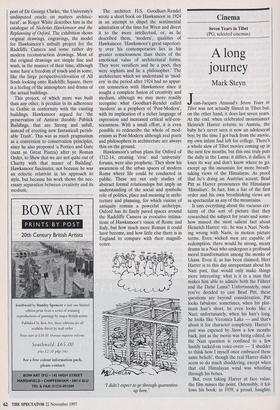Architecture
Nicholas Hawksmoor and the Replanning of Oxford (RIBA Heinz Gallery, till 20 December, Ashmolean Museum, Oxford, from 27 January until 13 April)
Dreaming of Italy
Alan Powers
Despite 300 years of Classicism between the 1530s and the 1830s, the moments in English architecture when you can get the genuine feeling of Italy are rare. The majority of English architects transcribed their sources too literally and, circumscribed by small-scale English ambi- tions and compromises, lost track of the essential qualities of scale and drama apparently produced without effort under Mediterranean skies. The light in England can be Italian, but our country houses, into which so much of the financial and artistic effort of our renaissance was poured, stand in too much greenery to effect a make- believe Italy. Roman magnificence is pro- duced by heaving up a great mass of stone, and this ought to be an essentially urban preoccupation.
As has often been remarked, the archi- tect Nicholas Hawksmoor (1661-1736) got closer to Italy by remaining in England and dreaming about it than many who travelled there to experience it directly. His contri- bution to the architecture of Oxford stands as a testimony to the power of imagination, consisting of a small number of realised buildings and a far greater number of unbuilt projects, developed with the sup- port of Dr George Clarke, 'the University's undisputed oracle on matters architec- tural', as Roger White describes him in the catalogue of Nicholas Hawksmoor and the Replanning of Oxford. The exhibition shows original drawings, engravings, the model for Hawksmoor's unbuilt project for the Radcliffe Camera and some rather dry modem reconstruction drawings. Most of the original drawings are simple line and wash, in the manner of their time, although some have a freedom of touch and in some, like the large perspective/elevation of All Souls looking onto Radcliffe Square, there is a feeling of the atmosphere and drama of the actual buildings.
This project, of which more was built than any other, is peculiar in its adherence to Gothic in conformity with the existing buildings. Hawksmoor argued for 'the preservation of Antient durable Publick Buildings, that are Strong and usfull, instead of erecting new fantasticall perish- able Trash'. This was as much pragmatism as a conversion to conservation principles, since he also proposed 'a Portico and Gate (next ye Great Piazza) after ye Roman Order, to Shew that we are not quite out of Charity with that maner of Building'. Hawksmoor fascinates, not because he was an eclectic relativist in his approach to style, but because his work shows the nec- essary separation between creativity and its medium. The architect H.S. Goodhart-Rendel wrote a short book on Hawksmoor in 1924 in an attempt to dispel the sentimental admiration of the time for Wren and divert it to the more intellectual, or, as he described them, 'modern', qualities of Hawksmoor. `Hawksmoor's great superiori- ty over his contemporaries lies in his greater consciousness than theirs of the emotional value of architectural forms. They were versifiers and he a poet, they were sophists and he a philosopher.' The architecture which we understand as 'mod- ern' in the period after 1924 had no appar- ent connection with Hawksmoor since it sought a complete fusion of creativity and medium, although we may more readily recognise what Goodhart-Rendel called `modern' as a prophecy of 'Post-Modem', with its implication of a richer language of expression and increased critical self-con- sciousness. With a small effort, it is even possible to redescribe the whole of mod- ernism as Post-Modern although real poets and philosophers in architecture are always thin on the ground.
Hawksmoor's urban plans for Oxford of 1712-14, creating 'civic' and 'university' forums, were also prophetic. They show his awareness of the urban spaces of modern Rome where life could be conducted in public. These are not only studies of abstract formal relationships but imply an understanding of the social and symbolic role of politics, place and meaning in archi- tecture and planning, for which visions of antiquity remain a powerful archetype. Oxford has its finely paved spaces around the Radcliffe Camera as evocative intima- tions of Hawksmoor's vision of Rome and Italy, but how much more Roman it could have become, and how little else there is in England to compare with their magnifi- cence.
7 didn't expect to go through quarantine up here.'



















































































 Previous page
Previous page